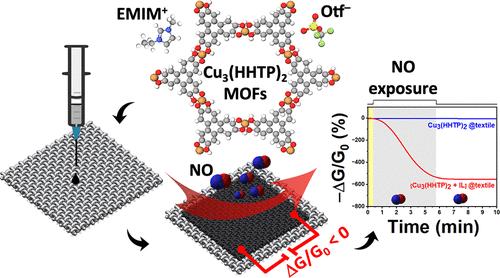智能纺织品:用于气敏应用的离子液体功能化Cu3(HHTP)2金属有机框架的电流体动力喷射打印
IF 8.2
2区 材料科学
Q1 MATERIALS SCIENCE, MULTIDISCIPLINARY
引用次数: 0
摘要
本研究介绍了一种基于离子液体(IL)功能化Cu3(HHTP)2金属有机框架(MOFs)集成的智能纺织品气体传感器的开发和表征,采用电流体动力射流(e-jet)打印。该传感器设计用于检测一氧化氮(NO)气体,这是各种环境和安全应用中的关键目标。合成Cu3(HHTP)2 mof,并用1-乙基-3-甲基咪唑三氟甲烷磺酸盐(EMIM+ Otf -)离子液体进行功能化,以提高其对NO气体的耐化学性能。然后将功能化的MOF电子喷射打印到静电纺聚乳酸(PLA)衬底上,以制造智能纺织品传感器。与之前报道的基于mof的传感器相比,il功能化Cu3(HHTP)2传感器的电导率提高了582倍。此外,IL功能化增强了传感器的灵敏度,响应从原始MOF@PLA传感器的不到5%增加到100 ppm NO气体时的约570%。系统地评估了一氧化氮浓度范围为5至300 ppm的性能,达到了3.7 ppm的理论检测极限。传感器表现出部分可逆性,并在较长时间和潮湿条件下保持功能。通过SEM、EDX、FTIR和XRD等综合分析,对MOF镀层的结晶度进行了评价,并阐明了其传感机理。这些发现强调了il功能化mof的电子喷射打印在开发先进、灵活的气体传感器方面的潜力,这些传感器可应用于民用和军用环境,并对个人防护可穿戴技术产生影响。本文章由计算机程序翻译,如有差异,请以英文原文为准。

Smart Textile: Electrohydrodynamic Jet Printing of Ionic Liquid-Functionalized Cu3(HHTP)2 Metal–Organic Frameworks for Gas-Sensing Applications
This study presents the development and characterization of a smart textile gas sensor based on the integration of ionic liquid (IL)-functionalized Cu3(HHTP)2 metal–organic frameworks (MOFs), using electrohydrodynamic jet (e-jet) printing. The sensor was designed for the detection of nitric oxide (NO) gas, a critical target in various environmental and safety applications. Cu3(HHTP)2 MOFs were synthesized and subsequently functionalized with 1-Ethyl-3-methylimidazolium trifluoromethanesulfonate (EMIM+ Otf–) ionic liquid to enhance their chemiresistive performance toward NO gas. The functionalized MOF was then e-jet printed onto electrospun polylactic acid (PLA) substrates to fabricate smart textile sensors. The IL-functionalized Cu3(HHTP)2 sensors demonstrated a 582× increase in conductivity compared to previously reported MOF-based sensors. Additionally, IL functionalization enhanced sensor sensitivity, with a response increasing from less than 5% in pristine MOF@PLA sensors to approximately 570% at 100 ppm of NO gas. Performance was systematically evaluated across NO concentrations ranging from 5 to 300 ppm, achieving a theoretical limit of detection of 3.7 ppm. The sensors exhibited partial reversibility and retained functionality over extended periods and under humid conditions. Comprehensive analyses using SEM, EDX, FTIR, and XRD were performed to assess the crystallinity of MOF deposits and elucidate the sensing mechanism. These findings highlight the potential of e-jet printing of IL-functionalized MOFs for the development of advanced, flexible gas sensors with applications in both civilian and military settings and implications for personal protective wearable technologies.
求助全文
通过发布文献求助,成功后即可免费获取论文全文。
去求助
来源期刊

ACS Applied Materials & Interfaces
工程技术-材料科学:综合
CiteScore
16.00
自引率
6.30%
发文量
4978
审稿时长
1.8 months
期刊介绍:
ACS Applied Materials & Interfaces is a leading interdisciplinary journal that brings together chemists, engineers, physicists, and biologists to explore the development and utilization of newly-discovered materials and interfacial processes for specific applications. Our journal has experienced remarkable growth since its establishment in 2009, both in terms of the number of articles published and the impact of the research showcased. We are proud to foster a truly global community, with the majority of published articles originating from outside the United States, reflecting the rapid growth of applied research worldwide.
 求助内容:
求助内容: 应助结果提醒方式:
应助结果提醒方式:


